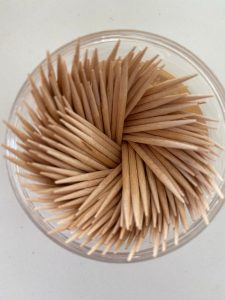 Nothing is more annoying than having food caught between your teeth. Toothpicks are handy to have around the house to clean your teeth. Whether you use them to pick your teeth or chew on them out of habit, dental professionals recommend keeping them out of your mouth. Although they are marketed for oral use, they can damage your gums and teeth. Here’s what you need to know to protect your pearly whites, so you don’t end up at an emergency dentist.
Nothing is more annoying than having food caught between your teeth. Toothpicks are handy to have around the house to clean your teeth. Whether you use them to pick your teeth or chew on them out of habit, dental professionals recommend keeping them out of your mouth. Although they are marketed for oral use, they can damage your gums and teeth. Here’s what you need to know to protect your pearly whites, so you don’t end up at an emergency dentist.
Oral Risks of Toothpicks
Toothpicks are created for dislodging food particles from your teeth, but using them doesn’t come without risks. You can introduce bacteria to your gums and damage dental work, but the complications don’t end there. Here’s why you may want to think twice before putting one in your mouth:
- Toothpicks can get stuck in your gums. Toothpicks can break off or splinter, which can cause fragments to get trapped in your gum tissue or cause oral injuries. Using them aggressively can lead to gum inflammation if the toothpick breaks. Instead of having food stuck in your teeth, you’ll have a dental emergency because the broken piece will need to be removed immediately.
- Toothpicks can cause infections. The pointy end of a toothpick can reach tight spaces in your mouth, but it’s easy to puncture your gums or cut your mouth. An open wound is vulnerable to bacteria that can cause infections. The toothpick itself can also cause infections if it hasn’t been stored in a clean container.
- Toothpicks damage dental work. If there’s any gap or issue with existing dental work, like a filling or veneer, it can damage it, or cause it to fall off altogether. Although they are durable, they aren’t as strong as natural teeth, which means they are easier to break.
Removing Objects Between Teeth
If you have food stuck between your teeth, don’t reach for a toothpick. Here are a few dentist-approved solutions:
- Use waxed dental floss to dislodge the debris. Look for one that has earned the American Dental Association’s Seal of Acceptance.
- Plastic-handled floss sticks can fit between teeth easily. The point at the end of the stick is softer than the wood used for toothpicks, so it’s less likely to damage your teeth.
- A waterflosser emits a pressurized stream of water that’s gentle on your teeth and gums. It can clean the most hard-to-reach areas in your mouth.
If home methods don’t free the object, it’s time to turn to professionals. Contact your emergency dentist for an appointment. They’ll get you into the office quickly to remove the piece of food, so you can get back to enjoying your day.
About Dr. Randall Nameth
Dr. Nameth earned his dental degree from the Ohio State University and has completed extensive continuing education in advanced services to treat the most complex oral health issues. If you have a dental emergency, don’t wait. Contact our office through our website or call us at (614) 505-4147 to request an appointment.
